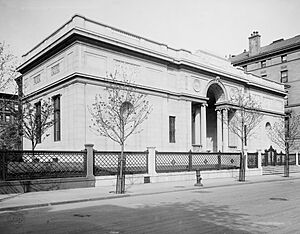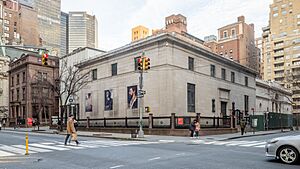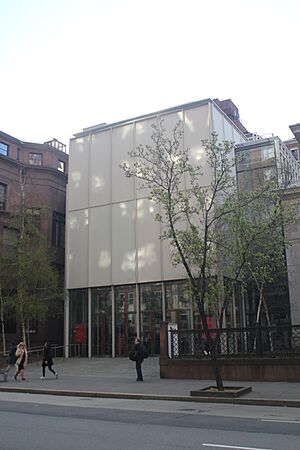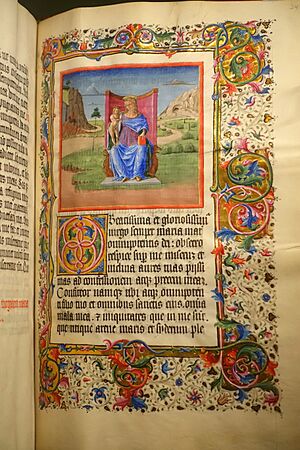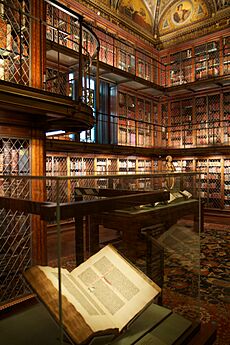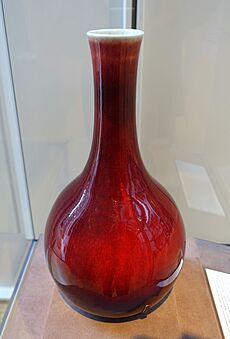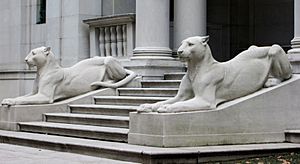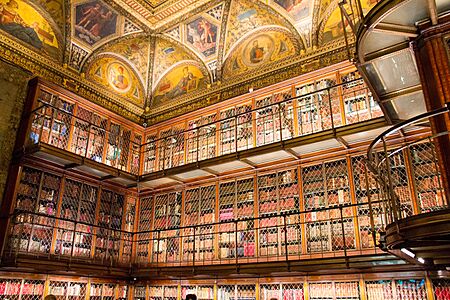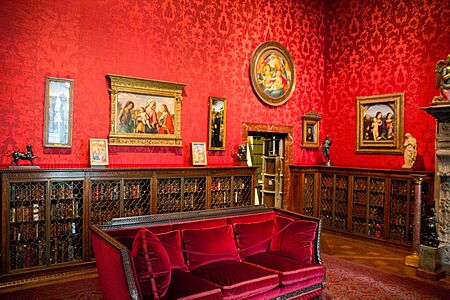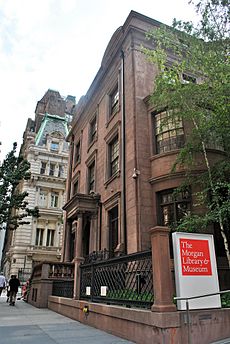- This page was last modified on 17 October 2025, at 10:18. Suggest an edit.
Morgan Library & Museum facts for kids
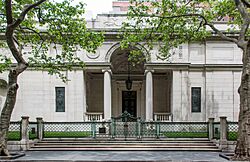
The main building
|
|
| Former name | Pierpont Morgan Library |
|---|---|
| Established | 1906 (private library) March 28, 1924 (public institution) |
| Location | 225 Madison Avenue (at East 36th Street), Manhattan, New York, U.S. |
| Type | Museum and research library |
| Collection size | 350,000 |
| Visitors | 274,000 (fiscal year 2019) |
| Founder | J. P. Morgan |
| Architect | Charles Follen McKim (main building) Benjamin Wistar Morris (main building annex) Isaac Newton Phelps (231 Madison Avenue) Renzo Piano and Beyer Blinder Belle (expansion) |
| Public transit access | Subway: Bus: M1, M2, M3, M4, M34 SBS, M34A SBS, M42, Q32 |
|
J. Pierpont Morgan Library
|
|
| NRHP reference No. | 66000544 |
| Significant dates | |
| Added to NRHP | November 13, 1966 (main building) |
| Designated NHL | November 13, 1966 (main building) |
The Morgan Library & Museum is a special place in New York City. It started as the private library of a famous banker named J. P. Morgan. He finished building it in 1906. This amazing building is located at 225 Madison Avenue in the Murray Hill area of Manhattan. Today, it is a museum and a research library. It is led by Colin B. Bailey and a group of trustees.
Before the library was built, the land had several homes belonging to the Phelps family. J. P. Morgan bought one of these homes in 1880. He collected thousands of rare items in the late 1800s. So, he built the main library building between 1902 and 1906. Belle da Costa Greene was its first librarian for over 40 years. In 1924, J. P. Morgan's son, John Pierpont Morgan Jr., made it a public place. This was what his father wanted. The library grew with new parts added in 1928, 1962, and 1991. In 2006, it was renamed the Morgan Library & Museum after a big expansion. More updates happened in 2010 and 2022.
The Morgan Library & Museum has several buildings. The main building was designed by Charles Follen McKim from the firm McKim, Mead and White. An extra part was designed by Benjamin Wistar Morris. A brownstone house from the 1800s, built by Isaac Newton Phelps at 231 Madison Avenue, is also part of the museum. The whole place now includes three more buildings. One of these is a glass entrance designed by Renzo Piano and Beyer Blinder Belle. The main building and its inside are protected as a New York City designated landmark and a National Historic Landmark. The house at 231 Madison Avenue is also a city landmark.
The Morgan Library & Museum has over 350,000 items. These include beautiful illuminated manuscripts, original writings by authors, rare books, and sheets of music. The Morgan also has collections of drawings, photos, paintings, maps, and other cool objects. Besides its main collection, the museum often has special exhibits. It also hosts events like concerts and talks. People have always admired the collection and the beautiful design of the first building. The newer parts have received mixed reviews.
Contents
Discovering the Morgan Library's History
Early Days and J.P. Morgan's Collection
In the late 1800s, the area where the Morgan Library now stands had four brownstone houses. These houses were built around 1852 by the Phelps Stokes/Dodge family. J. P. Morgan, a very rich banker, bought one of these houses in 1880. He wanted to live in the Murray Hill neighborhood.
Morgan started collecting things like old handwriting samples in the 1850s. He also bought pictures and stained glass. As he became richer, he collected fine art, rare books, and other special items. At first, he kept his books in the basement of his New York home. By 1883, he had 160 rare books.
His collection grew very fast after his father died in 1890. Morgan started buying important old writings. Between 1899 and 1902, he bought entire libraries. These included hundreds of illuminated manuscripts and prints. He also bought smaller collections of French literature and medieval stories. Morgan brought his art collection to the U.S. because a law in 1897 allowed him to do so without paying taxes. He wanted to keep these treasures safe for the American people.
Building the Library
By 1900, Morgan's collection was too big for his house. Some items had to be stored at the Lenox Library. Morgan decided to build a new library. In 1900, he bought land on 36th Street. He tore down two houses there to make space.
He hired Charles McKim to design the library in 1902. Morgan wanted a simple, beautiful building, calling it "a gem." The library was built with classical marble. Morgan chose pinkish-gray Tennessee marble instead of white. He wanted the building to look perfect. The builders used a special method called dry masonry. This meant the marble blocks fit together very tightly, almost without mortar. This made the building very strong and cost a lot of money.
The library was called "Mr. Morgan's jewel case." Morgan was very happy with McKim's work. He even had Belle da Costa Greene become his personal librarian. She was in charge of the collection for the next 40 years. The library was finished in 1906. It cost $1.2 million, which was a huge amount of money back then.
From Private to Public
Morgan first used his new office in November 1906. The collection was moved into the library later that year. To let people see his new library from Madison Avenue, Morgan tore down a nearby house. He replaced it with a garden designed by Beatrix Farrand.
As librarian, Belle da Costa Greene found new items for the collection. She also organized and researched each piece. She often looked for rare books in hidden places. Morgan wanted her to find items made before the 16th century. He also brought the rest of his collection to the U.S. To avoid taxes, he had to open the library to the public on certain days.
Morgan often met with bankers in the library's study. He preferred working there over his downtown office. He kept buying items until he died in March 1913. He had bought thousands of objects, including 600 old manuscripts.
After J. P. Morgan died, his son, Jack Morgan, inherited the library. J. P. Morgan wanted the collection to be "permanently available for the instruction and pleasure of the American people." Jack decided to keep the items already in the library. In 1914, the entire collection was shown at the Metropolitan Museum of Art. This was the only time the whole collection was displayed together.
Becoming a Public Museum
The Pierpont Morgan Library officially became a public institution in March 1924. Jack Morgan gave the collection to a group of trustees. He also gave $1.5 million to help run the library. Belle da Costa Greene stayed on as the librarian. At first, only researchers could enter the library. Jack Morgan said, "one soiled thumb could undo the work of 900 years." Only ten scholars could be in the building at once. The collection kept growing, focusing on very rare items.
To make space for more scholars, the Morgan Library planned an expansion in 1927. Jack Morgan's old house was torn down. Benjamin Wistar Morris designed the new part, which was finished in 1928. The library kept adding to its collections.
By the early 1940s, the library still only allowed researchers. City officials wanted to remove its tax-free status. In December 1942, the Morgan Library agreed to open to the public. Many valuable items were moved during World War II to protect them. They were returned in December 1944. In 1949, a group called the Fellows of the Pierpont Morgan Library was formed. They helped raise money for the collections.
Growth and Modernization
In the 1950s, the Morgan Library started hosting concerts and tours. It also bought more items, like 1,375 letters from a British dealer. In 1959, they started raising money for another expansion. This money would pay for changes to the annex and a new lecture hall.
In 1960, the main library and its annex were connected by a cloister. The renovation was finished in 1962. It cost $1.4 million and added office space, a gallery, and meeting rooms. By the early 1960s, the library was open six days a week. It did not charge an entry fee.
The library kept adding new collections in the 1970s and 1980s. These included music manuscripts, Italian drawings, and rare letters. The library also held many temporary exhibits. In the mid-1980s, the institution was officially renamed the Morgan Library.
In 1988, the Morgan Library bought the house at 231 Madison Avenue for $15 million. The library planned to spend $5 million to fix up the house. They also wanted to raise $40 million for a big project. The old buildings could only show one percent of the collection at a time.
In 1989, a glass conservatory was designed to connect 231 Madison Avenue and the main building's annex. This would make the library bigger and easier to access for everyone. The expansion was finished in October 1991. It cost $15 million.
By the mid-1990s, more visitors came to the library. The library also bought more art collections. In 1999, the Morgan opened a drawing center. By the early 2000s, the library's facilities were getting old.
The Big Expansion of the 2000s
The Morgan's leaders started planning another big expansion in the late 1990s. They chose the Italian architect Renzo Piano to design it. The plans included new exhibit areas, a reading room, an auditorium, and more storage space. The Morgan planned to raise $125 million for the project.
In May 2003, the Morgan Library buildings closed for construction. The collection was put into storage or moved to other places. The museum wanted to double its visitors from 200,000 a year. All the parts added after 1928 were torn down. Workers dug deep underground to build most of the new spaces. The entrance was also moved to Madison Avenue. The project cost $106 million.
The library reopened on April 29, 2006. It was renamed the Morgan Library & Museum. J. P. Morgan's private office and vault were also opened to the public. After the renovation, the number of visitors grew. The museum also started hosting concerts in its new auditorium.
In May 2010, the main building was renovated. This cost $4.5 million. It included cleaning the marble outside and updating the lights. The renovation was finished in October 2010. The Morgan also started a photography department in 2012.
In February 2019, the Morgan Library & Museum announced it would fix the main building's outside walls. A new garden was also designed around the original building. The garden opened to the public in June 2022. This renovation cost $13 million.
In 2024, the Morgan Library & Museum celebrated 100 years as a public institution. They started raising $50 million to celebrate.
Exploring the Morgan's Collections
The Morgan Library & Museum has over 350,000 objects. These include many different "treasures." You can find records for many of these items in the library's online catalog, Corsair.
Old Manuscripts and Letters
The Morgan Library & Museum has a large collection of illuminated manuscripts. These are beautiful handwritten books with colorful pictures and decorations. They date from the 500s to the 1500s. The library has over 1,100 of these manuscripts. Some famous ones include the Morgan Bible and the Hours of Catherine of Cleves.
The collection also has original writings by authors. Many of these have the author's own handwriting. You can see a Charles Dickens manuscript of A Christmas Carol. There are also writings from Ernest Hemingway, Jane Austen, and John Keats.
The Morgan has many old letters, some from ancient Babylonia. You can find original letters by Napoleon, Vincent van Gogh, and Marie Antoinette. There is also a rare letter from 1516 that describes the Southern Cross constellation for the first time.
The collection also includes notebooks and journals. These belonged to famous writers like Percy Bysshe Shelley and Henry David Thoreau. You can also see diaries from Queen Victoria and J. P. Morgan Sr. himself.
Music Treasures
The Morgan Library & Museum has a big collection of music manuscripts. It has 1,250 music manuscripts and 7,000 letters written by musicians. The music collection includes original scores and notes from famous composers like Ludwig van Beethoven, Johannes Brahms, and Wolfgang Amadeus Mozart.
One special item Morgan bought was Beethoven's Violin Sonata in G major. Other important pieces include Mozart's Haffner Symphony. The collection even has the scraps of paper where Bob Dylan wrote down "Blowin' in the Wind" and "It Ain't Me Babe". In 2024, museum staff found an unpublished waltz by Chopin from the 1830s.
Rare Books
The collection has very old Bibles and other religious books. It has three Gutenberg Bibles, which are some of the first books ever printed. It also has a rare copy of the Constance Missal and the Golden Gospels of Henry III. The Morgan also has items from ancient Egypt and medieval religious objects.
You can find many examples of old Latin and Greek books. There are also modern American and European printed books. The collection shows many beautiful examples of bookbinding. These include old Coptic manuscripts and metal covers from the Lindau Gospels.
The Morgan also has children's books. For example, it has a book with the first known printing of the rhyme "This Is the House That Jack Built". It also has first editions of Alice's Adventures in Wonderland and Max and Moritz.
Amazing Artworks
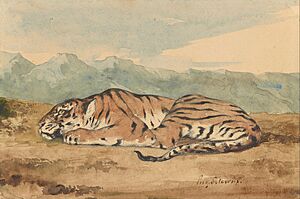
Royal Tiger by Eugène Delacroix, one of the paintings in the collection
The Morgan has a large collection of prints and drawings. It includes some Old Master paintings that J. P. Morgan collected. These include works by Hans Memling and Perugino. The collection also has many drawings from French artists like Antoine Watteau and Jacques-Louis David.
The Morgan has about 12,000 drawings and watercolors. Some famous ones include twelve William Blake watercolors and 54 drawings by Eugène Delacroix. The Morgan also has a photography department with works from different time periods.
Other Special Objects
J. P. Morgan collected many other decorations. These included a Persian carpet, Chinese vases, and an Egyptian carved stone. The collection also had royal jewels, old German silver, and Chinese porcelain. Morgan also kept various "knickknacks" like a 4,000-year-old Babylonian figure.
Today, the museum has a silver-gilt figure called Le Roi de Bourges. It also has the 12th-century Stavelot Triptych. Other notable objects include stage and costume designs. There is also an old map of the Palestine region from around 1300.
Programs and Events at the Morgan
The Morgan hosts many events and programs. These include concerts, films, and lectures. The museum has had concerts and tours since the 1950s. Regular concerts are now held in Gilder Lehrman Hall.
Guided tours of the main collection are offered every afternoon except Monday. The Morgan also has classes for school groups. Parties are held at the Morgan every year, like the Young Fellows Summer Cocktail Party.
The Morgan hosts different exhibits throughout the year. In the mid-1900s, the museum's yearly exhibits showed new items and rare books. Special exhibits were held in the annex buildings. The main building was kept for Morgan's main collection. After the 2006 expansion, the museum could host many exhibits at once.
The Morgan Library Buildings
The Main Building
The main building, also called the McKim Building, was built between 1902 and 1906. It was designed in the Classical Revival style by Charles Follen McKim. The building is 117 feet long and 50 feet wide. It has a "T" shape with an extension in the middle. A strong bronze fence with twisted bars surrounds the building.
Outside Design
The building's outside walls are made of Tennessee marble. McKim was inspired by old Roman buildings like the Villa Giulia. The walls are built with dry masonry, meaning the marble blocks fit together very tightly. This made the building very strong.
The main entrance is a large arch on 36th Street. It has an arched opening in the middle, with two smaller openings on the sides. Two lioness statues, made by Edward Clark Potter, stand next to the steps leading to the entrance. Above the entrance are special carvings that show poetry. The floor of the entrance area has a colorful mosaic tile pattern. Inside the entrance are bronze doors from the 1500s, brought from Florence. These doors have five carved bronze panels showing different scenes.
Inside the Main Building
The inside of the main library building is very fancy. It has a colorful rotunda, which is a round room. This room leads to three public rooms: Morgan's private study, the librarian's office, and the main library. To prevent fires, almost nothing in the library was made of wood. Morgan also had a steel vault for his most valuable manuscripts. The main building has 14,700 square feet of space.
The rotunda has beautiful murals and plasterwork on its ceiling. These were made by H. Siddons Mowbray. The floor of the rotunda is made of colorful marble. It looks like the floor of an old building in Vatican City. The walls have mosaic designs. When the library opened, the rotunda had two old chairs and a bronze statue. After a 2010 renovation, the rotunda now has display cases.
Morgan's study is called the West Room. Its design shows Morgan's personal style. The West Room has low wooden bookshelves and a marble fireplace. It also has stained glass windows and red wall coverings. The ceiling was bought from an Italian palace. The artist James Wall Finn painted coats-of-arms on the ceiling.
The original librarian's office is behind the rotunda. Since 2010, this room has been open to the public as the North Room. It displays ancient Roman, Greek, and Near Eastern objects.
The East Room is the largest room in the main building. It has tall bookcases with three levels. The bookcases are covered with glass. Some of them can even move to show a secret stairway. On the east wall of the East Room is a fireplace with a tapestry. The fireplace is from the 1400s and was brought from Italy. The ceiling has paintings of muses and famous artists.
Madison Avenue and 36th Street Annex
At the corner of Madison Avenue and 36th Street is a two-story building. It was designed by Benjamin Wistar Morris and finished in 1928. This building has offices, exhibit spaces, and a research library. It is made of the same Tennessee marble as the main building. This annex is simpler in design compared to the main building.
The Morris annex used to have a bookstore. After 1991, it became a gallery space. In the center of the Morris annex is the Marble Hall.
The Phelps Stokes/Morgan House
Another part of the library is the brownstone house at 231 Madison Avenue. This house is on the corner of Madison Avenue and East 37th Street. It was once the home of Isaac Newton Phelps and later J. P. "Jack" Morgan Jr. The house now has the Morgan Shop and the Morgan Dining Room. It is set behind a fence. The house was originally three stories tall. After a renovation in 1888, it became four stories tall.
House Exterior
The outside of the house on Madison Avenue has three sections. A set of steps leads to the main entrance. This entrance has two columns. The second and third floors have rectangular windows.
Along 37th Street, the house has different sections. The original part of the house has a balcony on the first floor. The 1888 addition has a projecting bay window.
House Interior
The house originally had 45 rooms. These included a ballroom and many fireplaces. After the museum's 1991 expansion, the house had offices, meeting rooms, and a gift shop. The ground floor rooms were used for lectures. After a 2006 renovation, one room became a dining room. The house's attic has the Thaw Conservation Center. This center has a library and rooms for taking care of old items.
New Entrance and Other Buildings
In 2006, three new buildings were finished. They were designed by Renzo Piano. These buildings include four galleries. The outside of the new buildings has pinkish steel and glass walls. They are set back a little from the other museum buildings. These new buildings added 75,000 square feet to the Morgan Library. Much of this space is underground.
The Entrance Building
The main new building is a four-story, steel-and-glass entrance on Madison Avenue. This building connects McKim's library, the annex, and the Phelps Stokes/Morgan house. The steel parts are painted a rose color to match the other buildings. Inside, a glass elevator connects the different levels.
The entrance building has the JPMorgan Chase Lobby, which is made of cherry wood. Stairs lead to the Morgan Shop and Morgan Dining Room. There is also a place to buy tickets and check coats. The Sherman Fairchild Reading Room is on the top floor. It has balconies and a skylight. The Gilder Lehrman Hall is an auditorium about 65 feet below street level. It has 280 seats. New storage rooms were also built deep underground. These rooms hold much of the Morgan Library's collection.
Connected Spaces
Gilbert Court is a covered courtyard in the middle of the complex. It surrounds the entrance building. The courtyard has a 50-foot-tall glass roof. On the south wall of the court is the Clare Eddy Thaw Gallery. This space is inspired by old Italian rooms. Stairs lead from the court to the original Morgan Library building. There is also a building next to 231 Madison Avenue with offices and a loading dock.
Old Buildings That Were Replaced
The new buildings from 2006 replaced all the additions built after 1928. These included a glass conservatory called the Garden Court. It was designed in 1991 and had a curved glass roof. This space had plants and a limestone wall.
The older additions also included a cloister built in 1960. This connected the main building and the Morris annex. A five-story addition with storage vaults and offices was built in 1975.
How the Morgan Library & Museum Works
Management and Leadership
The Morgan Library & Museum is run by a nonprofit organization. This group works to protect the artworks in the museum's collection. Colin Bailey has been the director since 2015. Because of a donation in 2024, the director's position is now called the Katharine J. Rayner Director until 2049. A board of trustees helps manage the museum. As of March 2024, Robert K. Steel and G. Scott Clemons were the co-presidents of the board.
Until 1981, a member of the Morgan family was always the president of the museum. Some past staff members have even given objects to the collection.
Visitors and Funding
As of 2024, the museum welcomes 250,000 visitors in person each year. Its online programs reach seven million more people. Starting in January 2024, college students can visit for free on the first Sunday of each month. The museum also offers free admission on Friday evenings if you reserve tickets. Most visitors are tourists, but local people also visit for events and new exhibits.
Jack Morgan started a $1.5 million fund for the Pierpont Morgan Library in 1924. This fund had grown to $53.5 million by the mid-1990s. By the early 2000s, it was $105 million. In 2023, the museum had $23.7 million in income and $31.4 million in expenses.
See also
 In Spanish: The Morgan Library & Museum para niños
In Spanish: The Morgan Library & Museum para niños

